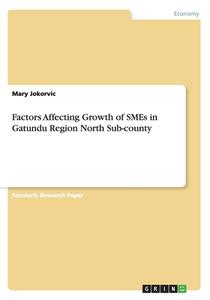
Factors Affecting Growth Of Smes In Gatundu Region North Sub-county
- Editore:
Grin Publishing
- EAN:
9783656639015
- ISBN:
3656639019
- Pagine:
- 20
- Formato:
- Paperback
- Lingua:
- Tedesco
Descrizione Factors Affecting Growth Of Smes In Gatundu Region North Sub-county
Research Paper (undergraduate) from the year 2012 in the subject Economics - Micro-economics, grade: B, The University of Chicago, language: English, abstract: About 99% of all the enterprises in the world are small or medium enterprises characterized of start up firms at the infant stage or well established SMEs. SMEs are essential in all economies especially to the developing countries characterized by major unemployment and income distribution challenges. In Kenya, SMEs are essential to the economy for which they are considered the main drivers. There are about 7.5 million SMEs in Kenya providing employment and income generating opportunities to low income sectors of the economy. The official policy framework of SMEs in Kenya is contained in the Sessional Paper No 2 of 2005: Development of Micro and Small Enterprises for Wealth and Employment Creation for Poverty Reduction. The policy forms the basis for enacting the SME Act which institutionalizes SME policy in Kenya (Syekei & Opijah, 2012). The contribution of the SMEs sector to the Gross Domestic Product (GDP) in Kenya increased from 13.8 percent in 1993 to about 40 percent by 2008. The sector further provides approximately 80% of the total employment and contributes about 92% of the new jobs created within the economy. The sector serves as the bedrock for industrializing the country in the future (Capital Markets Authority, 2010). In the developing countries such as Kenya, with large informal or micro enterprise sectors, SMEs constitute the middle of the size range, hence their strategic importance. SMEs are considerably more complicated in terms of the organizational structure as opposed to microenterprises but less complicated as opposed to large corporations with layers of management and high division of labor among other characteristics. In terms of technology SMEs are intermediate between high labor intensive technologies and high capital intensive technologies providing SMEs with a special role in generation of adequate or decent employment (Palma, 2005). Due to these characteristics various constraints lower SMEs resilience to risk and prevent them from growing and attaining economies of scale. The challenges faced by SMEs in Kenya are not limited to the areas of financing investments and working capital but also include human resource development, market access and access to modern technology and information. Consequently, there are various factors that have supported SMEs growth since the 1990s (Capital Markets Authority, 2010).



